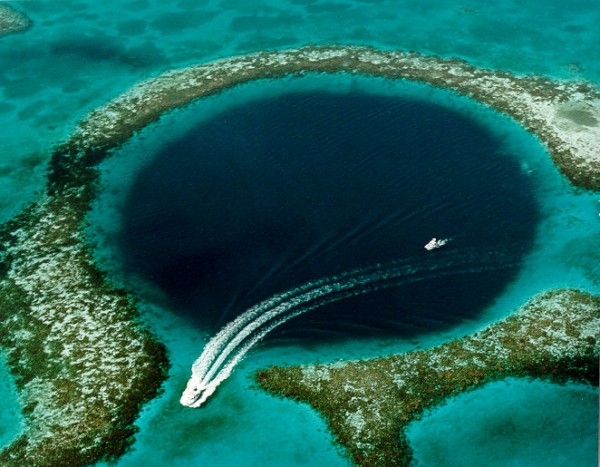Belize's Great Blue Hole Reveals Clues about the Disappearance of Mayan Civilization
| Ana Verayo | | Dec 30, 2014 08:45 AM EST |
(Photo : Wikimedia) The Blue Hole in the Caribbean holds the secret as to why the Mayans disappeared from the face of the planet.
It's a sight to behold. A perfect round hole in the ocean found near the coast of Belize in the Caribbean measures around 1,000 feet across and is 400 feet deep.
Scientists reveal this geological feature can also provide clues about the disappearance of the ancient Mayan civilization.
Like Us on Facebook
Research teams extracted samples from the aptly called Great Blue Hole and other lagoons in the area. The samples provide pivotal evidence the region experienced an extreme drought during the 9th century when the Mayan civilization was on the brink of destruction.
Apparently, the Mayans moved up north despite rains returning to the region. According to study co-author Andre Doxler of Rice University, this isn't the first time scientists believe a drought caused the Mayans' demise. These findings, however, makes a stronger case since it also originated from seven areas in the Mayan domain.
The peak of Mayan civilization lasted between 300 A.D. to 700 A.D. Their reign over the Yucatan Peninsula endured with the rise of massive pyramids that can still be seen today.
The Mayans created their own astronomy system and calendars. The Mayan calendar also famously predicted that the world would end in 2012.
After 700 A.D., warfare became rampant among the Mayans. While anarchy wrecked the Mayan civilization, it was drought that ultimately erased the Mayans from the face of the Earth.
Since 1995, scientists have been closely investigating growing evidence about the disappearance of this ancient civilization.
Just two years ago, a study published in the journal Science found a 2,000 year old stalagmite cave in Belize and evidence inside the cave presented a sharp decrease of rainfall during the same time Mayans started to vanish.
This particular drought hit the region so hard scientists consider it an intertropical convergence zone. The ITCZ caused heavy rains on the peninsula during the summer when it traveled south during the winter.
During 700 A.D. , however, the typical heavy rains expected in the summer eluded the peninsula as weather patterns shifted and bypassed the peninsula.
TagsBelize's Great Blue Hole Reveals Clues About the Disappearance of Mayan Civilization, mayan civilization, belize, great blue hole, why did the mayans disappear, yucatan peninsula
©2015 Chinatopix All rights reserved. Do not reproduce without permission
EDITOR'S PICKS
-

Did the Trump administration just announce plans for a trade war with ‘hostile’ China and Russia?
-

US Senate passes Taiwan travel bill slammed by China
-

As Yan Sihong’s family grieves, here are other Chinese students who went missing abroad. Some have never been found
-

Beijing blasts Western critics who ‘smear China’ with the term sharp power
-

China Envoy Seeks to Defuse Tensions With U.S. as a Trade War Brews
-

Singapore's Deputy PM Provides Bitcoin Vote of Confidence Amid China's Blanket Bans
-

China warns investors over risks in overseas virtual currency trading
-

Chinese government most trustworthy: survey
-

Kashima Antlers On Course For Back-To-Back Titles
MOST POPULAR
LATEST NEWS
Zhou Yongkang: China's Former Security Chief Sentenced to Life in Prison

China's former Chief of the Ministry of Public Security, Zhou Yongkang, has been given a life sentence after he was found guilty of abusing his office, bribery and deliberately ... Full Article
TRENDING STORY

China Pork Prices Expected to Stabilize As The Supplies Recover

Elephone P9000 Smartphone is now on Sale on Amazon India

There's a Big Chance Cliffhangers Won't Still Be Resolved When Grey's Anatomy Season 13 Returns

Supreme Court Ruled on Samsung vs Apple Dispute for Patent Infringement

Microsoft Surface Pro 5 Rumors and Release Date: What is the Latest?










